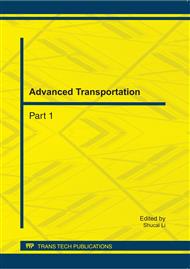p.535
p.542
p.546
p.550
p.554
p.560
p.566
p.570
p.576
Study on Integrated Land-Use of Rail Station Areas Based on Two-Way Balanced Passenger Flow
Abstract:
The implication and characteristics of integrated land-use of station areas were analyzed firstly. Then considering the current issue of unbalanced arriving and leaving passenger flow for a rail station caused by a single type land use in our country, a new way based on two-way balanced passenger flow to develop the rail station areas has been proposed and the related model has been constructed with a suggested solving algorithm. Finally, the model was checked and applied in Tashan Road station area development that is part of the planning project for line 5of Great Hexi, Changsha city.
Info:
Periodical:
Pages:
554-559
Citation:
Online since:
September 2011
Authors:
Keywords:
Price:
Сopyright:
© 2011 Trans Tech Publications Ltd. All Rights Reserved
Share:
Citation:


